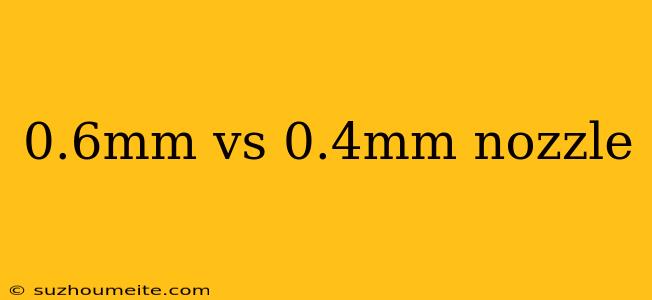0.6mm vs 0.4mm Nozzle: Which One is Right for You?
When it comes to 3D printing, the nozzle size is a crucial factor that affects the quality and speed of your prints. Two of the most popular nozzle sizes are 0.6mm and 0.4mm, each with its own strengths and weaknesses. In this article, we'll dive into the differences between these two nozzle sizes and help you decide which one is right for your 3D printing needs.
What is a Nozzle?
A nozzle is a small metal tip that extrudes melted filament in a 3D printer. It's responsible for depositing the filament onto the build plate, layer by layer, to create the desired object. The nozzle size determines the diameter of the extruded filament, which in turn affects the print quality, speed, and resolution.
0.6mm Nozzle
A 0.6mm nozzle is a larger nozzle that's commonly used for printing large objects, prototype models, or objects with simple geometries. Here are some benefits of using a 0.6mm nozzle:
Faster Printing Speeds
With a larger nozzle, you can achieve faster printing speeds without sacrificing too much detail. This makes it ideal for printing large objects or prototypes where speed is more important than detail.
Thicker Layers
The larger nozzle allows for thicker layers, which can result in faster printing times. This can be beneficial for printing objects with simple geometries or when you need to print a large object quickly.
Less Clogging
The larger nozzle opening reduces the risk of clogging, making it easier to print with thicker materials or at higher temperatures.
0.4mm Nozzle
A 0.4mm nozzle is a smaller nozzle that's commonly used for printing smaller objects, intricate details, or objects with complex geometries. Here are some benefits of using a 0.4mm nozzle:
Higher Detail and Resolution
The smaller nozzle allows for more precise extrusion, enabling higher detail and resolution in your prints. This makes it ideal for printing small objects, intricate details, or objects with complex geometries.
Thinner Layers
The smaller nozzle allows for thinner layers, which can result in more detailed prints. This can be beneficial for printing objects with intricate details or when you need high accuracy.
Better for Delicate Prints
The smaller nozzle opening makes it easier to print delicate objects or objects with small features, reducing the risk of warping or breaking.
Which Nozzle Size is Right for You?
So, which nozzle size is right for you? Here are some general guidelines to consider:
- Large objects or prototypes: 0.6mm nozzle
- Small objects or intricate details: 0.4mm nozzle
- General-purpose printing: 0.4mm nozzle (a good all-around choice)
Ultimately, the choice of nozzle size depends on your specific printing needs and preferences. You may need to experiment with different nozzle sizes to find the one that works best for your projects.
Conclusion
In conclusion, both 0.6mm and 0.4mm nozzles have their own strengths and weaknesses. By understanding the benefits and limitations of each nozzle size, you can make an informed decision about which one is right for your 3D printing needs. Remember to consider the type of objects you want to print, the level of detail required, and your printing speed preferences when choosing the right nozzle size for your projects.
